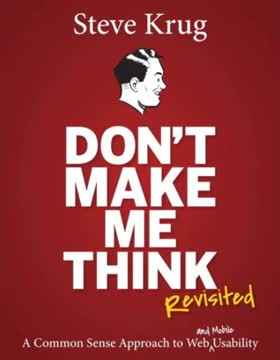Key Takeaways
1. Our perception is biased by experience, context, and goals
What we perceive is not an accurate reflection of our environment. It is biased by at least three factors: past experience, current context, and future goals.
Experience shapes perception. Our brains interpret sensory input based on prior experiences, leading to phenomena like:
- Perceptual priming: We more easily recognize objects we've recently seen
- Mental frames: We fill in missing details based on familiar patterns
- Habituation: We become less sensitive to repeated stimuli
Context influences interpretation. The same sensory input can be perceived differently depending on:
- Surrounding visual elements
- Auditory cues
- Cultural context
- Emotional state
Goals direct attention. Our current objectives act as a filter, causing us to:
- Notice goal-relevant information more readily
- Overlook unrelated details, even if they're obvious (inattentional blindness)
- Interpret ambiguous stimuli in ways that align with our goals
2. Vision is optimized for structure and contrast, not absolute brightness
Our vision is optimized to detect contrasts (edges), not absolute brightness.
Edge detection is key. The visual system is highly attuned to:
- Boundaries between light and dark areas
- Changes in color or texture
- Shapes and outlines of objects
Relative differences matter more than absolutes. This explains visual illusions where:
- The same shade of gray appears lighter or darker depending on its surroundings
- We can recognize objects in various lighting conditions
Color perception is complex. Our ability to distinguish colors depends on:
- The size of the colored area
- The background and surrounding colors
- The overall illumination level
These principles have important implications for user interface design:
- Use contrast to draw attention to important elements
- Be mindful of color combinations, especially for users with color vision deficiencies
- Ensure that information isn't solely conveyed through subtle color differences
3. Peripheral vision is poor but serves important functions
Our peripheral vision is roughly equivalent to looking through a frosted shower door, and yet you enjoy the illusion of seeing the periphery clearly.
Foveal vs. peripheral vision. The human visual field has:
- A small area of high acuity (fovea) at the center
- A much larger area of low resolution in the periphery
Despite this limitation, peripheral vision serves crucial functions:
- Guiding eye movements to interesting areas
- Detecting motion and potential threats
- Providing context and a sense of spatial awareness
Implications for interface design:
- Important information should be placed near the center of the visual field
- Use motion or contrast in the periphery to draw attention when necessary
- Don't rely on fine details being noticed in peripheral areas
- Consider how information is distributed across the entire display
4. Reading is an unnatural skill that can be disrupted easily
Reading is an artificial skill that we learn by systematic instruction and practice, like playing a violin, juggling, or reading music.
Reading is a learned skill. Unlike spoken language, humans didn't evolve to read naturally:
- It requires explicit training and practice
- The brain repurposes existing neural circuits for this task
The reading process is complex. It involves:
- Rapid eye movements (saccades) between fixation points
- Recognition of letter shapes and word forms
- Integration with language processing areas of the brain
Many factors can disrupt reading:
- Unfamiliar vocabulary or jargon
- Poor typography or layout
- Low contrast between text and background
- Distracting visual elements
To support efficient reading in interfaces:
- Use clear, familiar language
- Ensure good contrast and legibility
- Organize text with clear hierarchies and structure
- Minimize unnecessary text and visual clutter
5. Attention and memory have severe limitations
Short-term memory covers situations in which information is retained for intervals ranging from a fraction of a second to a few minutes. Long-term memory covers situations in which information is retained over longer periods (e.g., hours, days, years, even lifetimes).
Working memory is limited. Humans can typically hold:
- Only 3-5 items in working memory at once
- Information for just a few seconds without rehearsal
Long-term memory is vast but imperfect. It is:
- Susceptible to distortion and false memories
- Strongly influenced by emotions and repetition
- More focused on general patterns than specific details
Implications for interface design:
- Break complex tasks into smaller steps
- Provide clear, persistent information about system state
- Use recognition rather than recall where possible
- Offer external memory aids (e.g., history lists, saved preferences)
- Design for interruptions and task resumption
6. We prefer familiar paths and struggle with novel actions
Learning from experience and performing well-learned actions are easy largely because they don't require constant awareness or focused attention and because they can occur in parallel.
Automatic vs. controlled processing. Human cognition operates in two modes:
- Automatic (System 1): Fast, effortless, unconscious
- Controlled (System 2): Slow, effortful, conscious
Familiarity breeds efficiency. Well-practiced actions become automatic, allowing for:
- Faster execution
- Lower cognitive load
- Ability to multitask
Novel actions are challenging. They require:
- More conscious attention
- Greater mental effort
- Slower execution and higher error rates
To support users, interfaces should:
- Leverage familiar patterns and conventions
- Provide clear paths for common tasks
- Offer guidance for novel or complex actions
- Allow for gradual learning and increasing efficiency
7. Decision-making is rarely rational and easily influenced
Economists often assume that decision making is rational and stable, but research indicates that human decision making is rarely so.
Cognitive biases affect decisions. Common biases include:
- Loss aversion: We fear losses more than we value equivalent gains
- Framing effects: How choices are presented influences our decisions
- Availability heuristic: We overestimate the probability of events we can easily recall
Emotions play a significant role. Decisions are often driven by:
- Gut feelings and intuitions
- Immediate emotional responses
- Subconscious associations
Context shapes choices. Decisions are influenced by:
- Recent experiences and priming
- Social pressure and norms
- Environmental factors (e.g., time pressure, cognitive load)
Implications for interface design:
- Be aware of how information presentation can bias decisions
- Provide clear, objective information to support rational choices
- Consider the emotional aspects of user experience
- Offer tools to compare options and analyze trade-offs
8. Hand-eye coordination follows predictable laws
The larger your target on a screen and the nearer it is to your starting point, the faster you can point to it.
Fitts' Law governs pointing tasks. It states that:
- Larger targets are easier and faster to hit
- Closer targets are easier and faster to hit
- The relationship is logarithmic, not linear
The Steering Law applies to path-following tasks. It predicts that:
- Wider paths are easier to navigate
- Shorter paths are easier to navigate
These laws have important implications for interface design:
- Make frequently used controls larger and/or closer to common starting points
- Provide ample space between clickable elements to prevent errors
- Consider the trade-offs between menu designs (e.g., linear vs. radial)
- Optimize gestures and drag-and-drop interactions based on these principles
9. Responsive systems must meet specific time requirements
To be perceived by users as responsive, interactive software must follow these guidelines: Acknowledge user actions instantly, even if returning that the answer will take time; preserve users' perception of cause and effect.
Human perception has inherent time constraints. Key thresholds include:
- 0.1 seconds: Limit for perceived instantaneous response
- 1 second: Maximum delay before users feel interrupted
- 10 seconds: Limit of focused attention without feedback
Responsiveness is crucial for user satisfaction. It involves:
- Providing immediate feedback for actions
- Keeping users informed about system state
- Allowing for task interruption and resumption
Strategies for improving perceived responsiveness:
- Use visual indicators for system status (e.g., progress bars, spinners)
- Prioritize the display of critical information
- Perform background processing and preloading when possible
- Break long operations into smaller, interruptible steps
By aligning system behavior with human perceptual and cognitive limitations, designers can create interfaces that feel more natural, efficient, and satisfying to use.
Last updated:
FAQ
What's Designing with the Mind in Mind about?
- User Interface Design Focus: The book is a guide to understanding user-interface design through the lens of human psychology, emphasizing cognitive and perceptual influences on design.
- Psychological Principles: It delves into psychological principles like perception biases, memory limitations, and attention constraints that affect user interactions with interfaces.
- Practical Applications: Jeff Johnson provides practical advice on applying these principles to create more effective and user-friendly designs.
Why should I read Designing with the Mind in Mind?
- Enhance Design Skills: The book helps designers understand the psychological underpinnings of user behavior, leading to improved design choices.
- Evidence-Based Guidelines: It offers evidence-based guidelines to enhance usability and user experience in software and web design.
- Broader Understanding: Beneficial for anyone involved in human-computer interaction, it deepens understanding of user needs.
What are the key takeaways of Designing with the Mind in Mind?
- Cognitive Bias Awareness: Recognizing perception biases is crucial for designing interfaces that align with user expectations.
- Visual Structure Importance: Emphasizes the need for clear visual hierarchies in information presentation.
- Memory and Attention Limits: Guides designers to create systems that support users in managing cognitive load.
What are the best quotes from Designing with the Mind in Mind and what do they mean?
- Thoughtful Application: "User-interface design rules must be applied thoughtfully, not mindlessly," stresses understanding the rationale behind guidelines.
- Recognition vs. Recall: "Recognition is easy; recall is hard," highlights the need for designs that facilitate recognition.
- User Focus: "We focus on our goals and pay little attention to our tools," suggests interfaces should be intuitive and unobtrusive.
What are the main psychological principles discussed in Designing with the Mind in Mind?
- Perception Biases: Discusses how perceptions are influenced by past experiences, current context, and future goals.
- Gestalt Principles: Covers principles like proximity and similarity, explaining how users visually group information.
- Memory Types: Differentiates between short-term and long-term memory, emphasizing minimizing cognitive load.
How does Designing with the Mind in Mind address color vision limitations?
- Color Contrast Focus: Emphasizes using high contrast in designs to enhance visibility and comprehension.
- Color-Blindness Considerations: Discusses the prevalence of color-blindness and provides guidelines for accessible color use.
- Guidelines for Color Use: Offers practical advice on effectively using color in user interfaces.
What design strategies does Designing with the Mind in Mind recommend for improving user interfaces?
- Clear Visual Hierarchy: Advocates for creating a visual hierarchy for efficient navigation.
- Consistent Layouts: Emphasizes consistency in design elements to reduce cognitive load.
- Feedback Mechanisms: Highlights the importance of providing immediate and clear feedback for user actions.
How does Designing with the Mind in Mind explain the concept of "inattentional blindness"?
- Definition: Describes it as the phenomenon where users fail to notice objects when focused on a specific task.
- Real-World Examples: Provides examples like the "invisible gorilla" experiment to illustrate the concept.
- Design Implications: Helps designers create interfaces that draw attention to important elements.
What role does memory play in user interface design according to Designing with the Mind in Mind?
- Memory Limitations: Discusses how limited working memory affects user interactions.
- Recognition vs. Recall: Emphasizes designs should facilitate recognition rather than rely on recall.
- Use of External Aids: Suggests incorporating visual cues and reminders to aid users.
What is Fitts' Law as described in Designing with the Mind in Mind?
- Pointing Behavior: States that the time to move to a target is a function of distance and size.
- Design Implications: Suggests designing interface elements with adequate size and spacing.
- Formula Overview: Provides the formula T = a + b * log2(D/W) for calculating target selection time.
How does Designing with the Mind in Mind address the concept of responsiveness?
- Critical to User Satisfaction: Emphasizes responsiveness as crucial for user satisfaction.
- Timely Feedback: Discusses the need for immediate feedback to maintain user control and engagement.
- Design Guidelines: Provides guidelines for achieving responsiveness, like using busy indicators.
What are some common pitfalls in user interface design mentioned in Designing with the Mind in Mind?
- Ignoring User Feedback: Warns against neglecting user feedback, which can lead to frustration.
- Overcomplicating Interfaces: Advises against creating overly complex interfaces that increase cognitive load.
- Inconsistent Design Elements: Stresses the importance of consistency to avoid user confusion.
Review Summary
Designing with the Mind in Mind receives mostly positive reviews, praised for its insights into cognitive psychology and UI design principles. Readers appreciate the practical examples and scientific explanations. Some find it dry or dated but still valuable. Many recommend it as a must-read for designers and developers. Critics note it could be more comprehensive and practical. Overall, reviewers value the book's unique perspective on applying cognitive science to interface design, though some desire more actionable advice.
Similar Books










Download PDF
Download EPUB
.epub digital book format is ideal for reading ebooks on phones, tablets, and e-readers.




